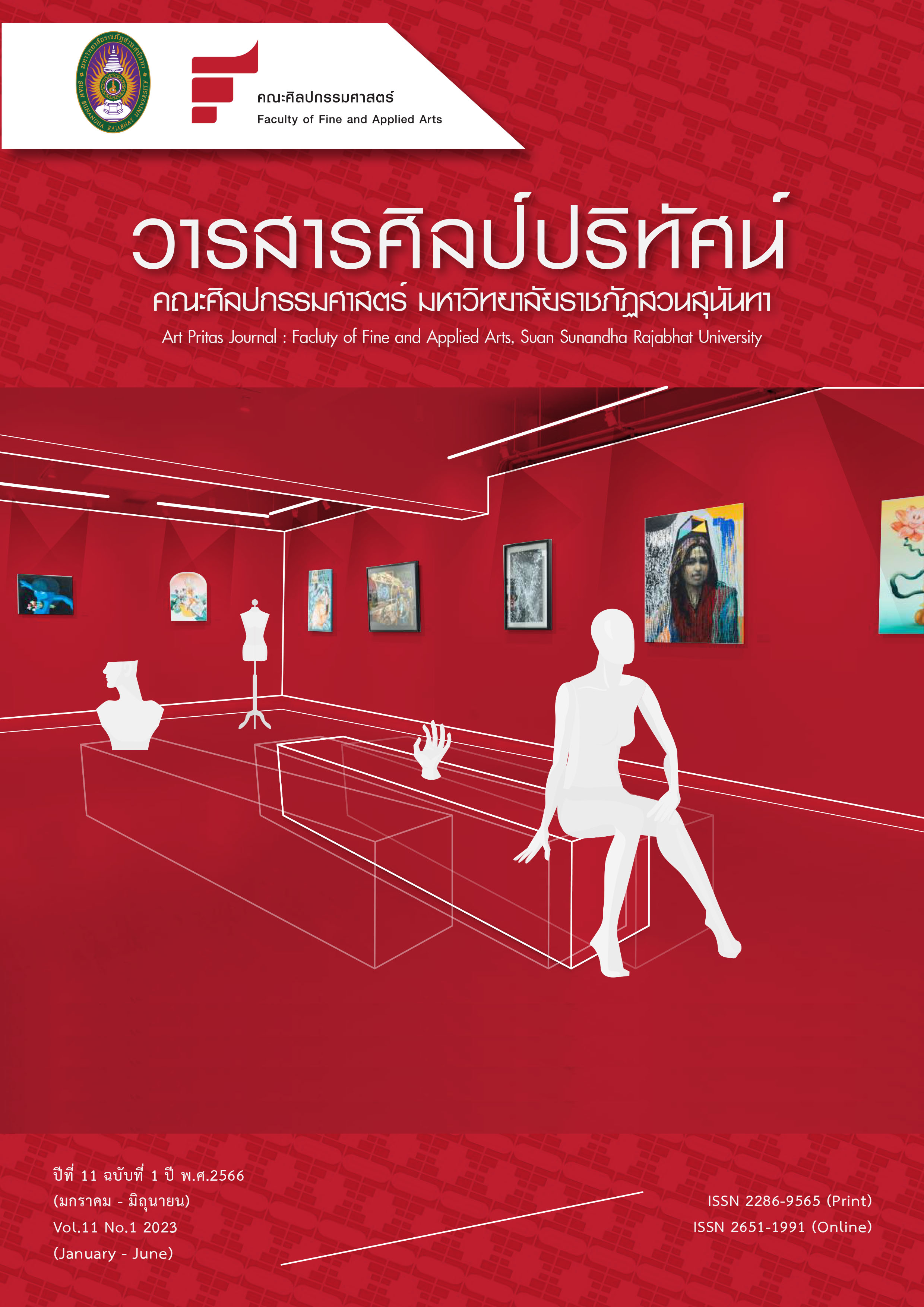กระบวนการกำกับการแสดงเรื่อง “เช่า เขา อยู่” ละครอิมเมอร์ซีฟเฉพาะที่บนพื้นที่ออนไลน์
Main Article Content
บทคัดย่อ
งานวิจัยสร้างสรรค์ชิ้นนี้มีวัตถุประสงค์เพื่อศึกษากระบวนการสร้างสรรค์การแสดงรูปแบบอิมเมอร์ซีฟเฉพาะที่ และทดลองกำกับการแสดง เรื่อง “เช่า เขา อยู่” ของ นฤทธิ์ ปาเฉย ในรูปแบบละครอิมเมอร์ซีฟเฉพาะที่บนพื้นที่ออนไลน์ ผ่านแอพลิเคชั่น ซูม คลาวด์มีตติ้ง ซึ่งนอกจากจะเป็นการปรับตัวในสถานการณ์การแพร่ระบาดของโรคโควิด 19 แล้ว ยังเป็นการมุ่งหน้าสู่จักรวาลนฤมิตซึ่งเข้ามามีบทบาทกับวิถีชีวิตมนุษย์มากขึ้น จึงอาจเป็นแนวทางของการสร้างสรรค์ละครเวทีรูปแบบใหม่ในอนาคต
ผู้วิจัยได้วิเคราะห์ข้อมูลต่าง ๆ และสังเคราะห์เป็นกระบวนการกำกับการแสดงเรื่อง “เช่า เขา อยู่” ซึ่งมุ่งสร้างองค์ประกอบของละครอิมเมอร์ซีฟตามทัศนะของ โรส บิกกิ้น ให้เหมาะสมกับพื้นที่ออนไลน์ดังนี้คือ 1) ปรับพื้นที่และสภาพแวดล้อมที่ตั้งใจจะจัดในอาคารพาณิชย์ร้างแห่งหนึ่งในเยาวราช มาเป็นพื้นที่เสมือนบนแอพลิเคชั่น ซูม คลาวด์ มีตติ้ง 2) สร้างเรื่องเล่าแบบหลากลำดับเรื่องให้ผู้ชมแต่ละคนเลือกลำดับการรับชมได้ด้วยตนเอง และ 3) ออกแบบให้ผู้ชมมีปฏิสัมพันธ์ต่อเรื่องเล่า ต่อผู้ชมด้วยกันเอง และต่อผู้แสดงผ่านกิจกรรมต่าง ๆ จากนั้นจึงนำเสนอต่อผู้ชมทั่วไป ผลการวิจัยบ่งชี้ว่าการสร้างองค์ประกอบทั้ง 3 ของละครอิมเมอร์ซีฟให้สัมพันธ์กันอย่างมีเอกภาพช่วยให้ผู้ชมเชื่อว่าตนเป็นส่วนสำคัญในใจกลางของการแสดง และมีปฏิสัมพันธ์กับเรื่องได้ไม่ต่างจากการจัดแสดงบนพื้นทางกายภาพ ผู้วิจัยมีข้อเสนอแนะว่าควรให้มีการสร้างสรรค์ละครอิมเมอร์ซีฟเฉพาะที่บนพื้นที่ออนไลน์ในสื่ออื่นอีก เพื่อค้นหารูปแบบการแสดงออนไลน์ใหม่ ๆ ซึ่งจะช่วยพัฒนาศิลปะการละครให้ก้าวไปในจักรวาลนฤมิตอย่างสร้างสรรค์ต่อไป
Article Details

อนุญาตภายใต้เงื่อนไข Creative Commons Attribution-NonCommercial-NoDerivatives 4.0 International License.
เนื้อหาและข้อมูลในบทความที่ลงตีพิมพ์ในวารสารศิลป์ปริทัศน์ ถือเป็นข้อคิดเห็นและความรับผิดชอบของผู้เขียนบทความโดยตรง ซึ่งกองบรรณาธิการวารสารไม่จำเป็นต้องเห็นด้วย หรือร่วมรับผิดชอบใดๆ
บทความ ข้อมูล เนื้อหา รูปภาพ ฯลฯ ที่ได้รับการตีพิมพ์ในวารสารศิลป์ปริทัศน์ถือเป็นลิขสิทธิ์ของวารสารศิลป์ปริทัศน์
เอกสารอ้างอิง
Baía Reis, A., & Ashmore, M. (2022). From video streaming to virtual reality worlds: an academic, reflective, and creative study on live theatre and performance in the metaverse. International Journal of Performance Arts and Digital Media, 18(1), 7-28.
Biggin, R. (2017). Immersive Theatre and Audience Experience: Space, Game and Story in the Work of Punchdrunk. Springer International Publishing.
Bouko, C. (2014). Interactivity and immersion in a media-based performance. PARTICIP@TIONS, 11(1), 254-269.
Clurman, H. (1997). On Directing. Simon & Schuster.
Couclelis, H., & Gale, N. (1986). Space and spaces. Geografiska Annaler: Series B, Human Geography, 68(1), 1-12.
Hogan, P. C. (2012). A Guide for Humanists. Cognitive Science, Literature, and the Arts:. Taylor & Francis.
Karyn, S. (2018). Our Favorite Ways to Watch Theatre Online – Updated! . Theatretrip. Retrieved May, 21st
Machon, J. (2013). Immersive Theatres: Intimacy and Immediacy in Contemporary Performance. Palgrave Macmillan.
Nodaway Valley Bank. (2022). Security Center. Retrieved 7 June 2022 from https://www.nvb.com/education-center/security-center/
Phelan, P. (1993). Unmarked: The Politics of Performance. Routledge.
Stern, N. (2011). The Implicit Body as Performance: Analyzing Interactive Art. Leonardo, 44, 233-238.
คันฉัตร รังษีกาญจน์ส่อง. (2563). บทบันทึกถึงละครเวทีไทยท่ามกลางวิกฤตโควิด-19. Retrieved 7 มิถุนายน 2565 from https://themomentum.co/stage-play-covid-19
อารียา สุขโต. (2565). รู้จัก Metaverse จักรวาลนฤมิต : โลกเสมือนที่เป็นจริง. Retrieved 7 มิถุนายน 2565 from


